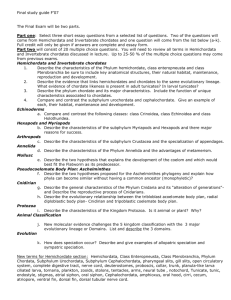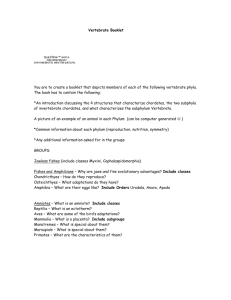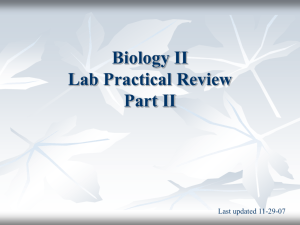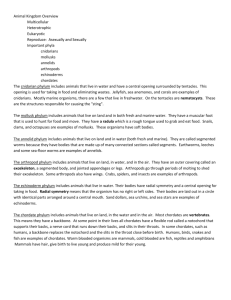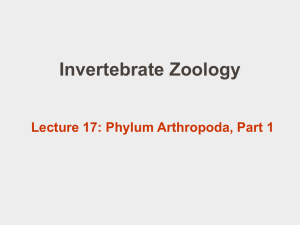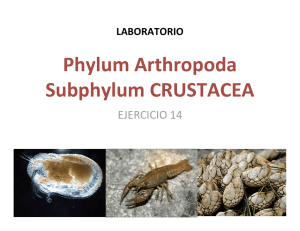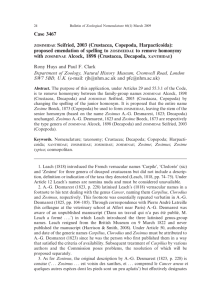Major Animal Phyla
advertisement
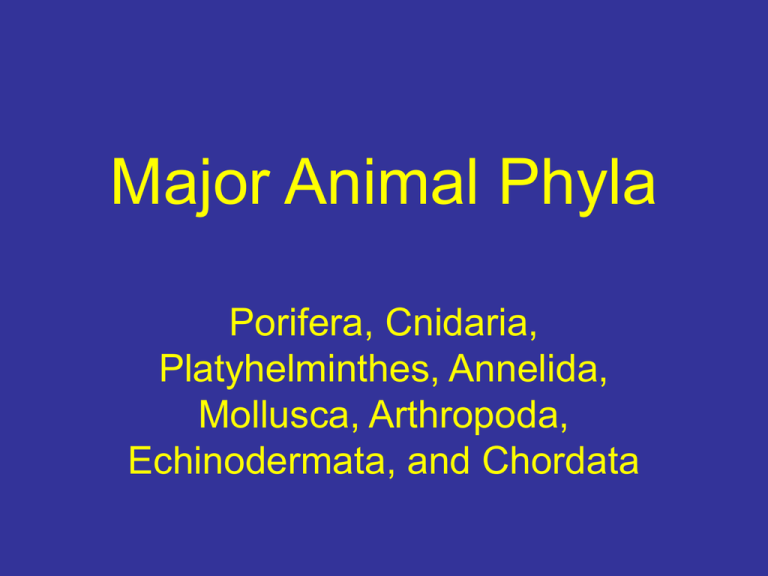
Major Animal Phyla Porifera, Cnidaria, Platyhelminthes, Annelida, Mollusca, Arthropoda, Echinodermata, and Chordata Phylum Porifera sponges • • • • • • Have no definite shape – asymmetrical; No tissues or organs Colony of specialized cells Immobile Good powers of regeneration Skeleton of spongin and spicules CLASSES OF SPONGES • Class Calcarea – has calcium carbonate spicules • Class Hexactinellida – glass sponges with spicules of silica • Class Demospongiae – no spicules, only spongin SPONGE ANATOMY Barrel sponge Vase sponge Tube sponge Venus Flower Basket Phylum Cnidaria stinging-celled animals • • • • • • Jellyfishes, corals, anemones Radial symmetry Two tissue layers with inner mesoglea Primitive nerve net but no brain 2-way digestive tract Stinging cells for capturing food. CLASSES OF CNIDARIANS • Class Hydrozoa – Hydra, PortugueseMan-of-War, Obelia; mostly polyp or hydroid stage • Class Scyphozoa – true jellyfishes; mostly medusa stage • Class Anthozoa – corals, anemones • Class Cubozoa – box jellies CLASS HYDROZOA Hydra CLASS SCYPHOZOA Moon jelly CLASS ANTHOZOA Sea anemone Aggregating anemones Anemone Coral polyps Coral reef CLASS CUBOZOA Phylum Platyhelminthes flatworms • First animals to exhibit bilateral symmetry • Have primitive brain • 3 tissue layers • Includes free-living flatworms and parasitic flatworms (tapeworms, flukes) CLASSES OF FLATWORMS • Class Turbellaria – free-living flatworms • Class Cestoda – tapeworms • Class Trematoda - flukes Flatworm Flatworm Flatworm Tapeworm head (scolex) Liver fluke Phylum Annelida segmented worms • Earthworms, sandworms, leeches • One-way digestive system • Have well-developed digestive and circulatory systems CLASSES OF ANNELIDS • Class Oligochaeta – earthworms, bloodworms; oligo- means “few” and chaeta means a “bristle” or stout hair • Class Polychaeta – many bristles and parapodia (fleshly lobes to “walk” with • Class Hirudinea – leeches (most are NOT bloodsuckers) Christmas tree worm Feather-duster worm Fireworm Nereis – a polychaete Oligochaete Leech Phylum Molluscasoft bodied animals • includes snails, slugs, nudibranchs, chitons, limpets, clams, oysters, squid, octopus, nautilus, etc. • Either have no shell, one shell, or two shells • Many have hard mouth parts (radula in gastropods, beak in cephalopods). CLASSES OF MOLLUSCS • Class Gastropoda – snails, slugs, conchs, nudibranchs; have either no shell or one shell; name means “stomach foot” • Class Bivalvia – clams, oysters, mussels; have two shells that hinge together • Class Polyplacophora – chitons; snail-like with 8 embedded plates on its back • Class Cephalopoda – squid, octopus, nautilus, cuttlefish; name means “head foot”; welldeveloped nervous system Nudibranch Nudibranch Nudibranch Chiton Chiton Reef Squid Cuttlefish Blue-ring octopus Chambered nautilus Triton shell Oyster on half-shell (needs Tabasco) Scallop Phylum Arthropoda – joint-legged animals • includes insects, crustaceans, centipedes, millipedes, and arachnids • exoskeleton made of chitin • must shed shell to grow CLASSES OF ARTHROPODS • Class Crustacea – shrimps, lobsters, crabs, crawfishes • Class Amphipoda – small; called scuds • Class Isopoda – sea lice; some are parasitic • Class Stomatopoda – mantis shrimps • Class Pycnogonida – sea spiders • Class Merostomata – horseshoe crabs • Class Cirripedia - barnacles Bulldozer larva - Crustacea Bulldozer Cleaner shrimp Crustacea Spider crab Crustacea Crab zoea crustacea Crab megalops Stone crab Hermit crab - crustacea Amphipoda Giant Isopod Parasitic isopod Ligia exotica - isopod Mantis shrimp - Stomatopoda (thumbsplitter) Horseshoe crab Merostomata Sea spider- Pycnogonida Barnacles - Cirripedia Phylum Echinodermata – spiney-skinned animals • includes sea stars, brittle stars, sea urchins, sand dollars, sea cucumbers, and crinoids • reverted back to radial symmetry (radial in adults / bilateral in larvae) • tube feet and water vascular system • Most exhibit pentamerism WHY ARE ECHINODERMS RANKED SO HIGH? • Clues from embryology – study of the early development of animals • Protostomes versus Deuterostomes • Protostome – blastopore forms the mouth in all animals except echinoderms and chordates • Deuterostomes – blastopore forms the anus in echinoderms and chordates CLASSES OF ECHINODERMS • Class Asteroidea – sea stars • Class Ophiuroidea – brittle stars, serpent stars • Class Echinoidea – sea urchins, sand dollars • Class Holothuroidea – sea cucumbers • Class Crinoidea – sea lilies, feather stars Sea star - Asteroidea Bat star Asteroidea Pycnopodia - Asteroidea Brittle star - Ophiuroidea Sea urchin - Echinoidea Purple urchins Echinoidea Sand dollar - Echinoidea Sea cucumber Holothuroidea Feather star - Crinoidea Phylum Chordata • Includes fish, amphibians, reptiles, birds, and mammals • Chordate characteristics: • Dorsal hollow nerve tube • Notochord • Pharyngeal gill slits • Post anal tail CHORDATE CLASSIFICATION • The Protochordates - invertebrate chordates • Subphylum Urochordata – sea squirts, salps, and ascidians • Subphylum Cephalochordata – lancelets • True Chordates: • Subphylum Vertebrata Tunicate - Urochordata Tunicate - Urochordata Salp- Urochordata CEPHALOCHORDATE Amphioxus SUBPHYLUM VERTEBRATA • Class Agnatha – jawless fishes; lampreys and hagfishes • Class Chondrichthys – cartilaginous fishes; sharks, rays, skates, chimeras • Class Osteichthys – boney fishes • Class Amphibia – frogs, salamanders • Class Reptila – turtles, snakes, lizards, and crocodilians • Class Aves – birds • Class Mammalia - mammals VERTEBRATE BODY PLAN • Recapitulation Theory – Ontogeny recapitulates Phylogeny • The embryological and developmental changes an organism goes through restates its evolutionary history • Evolution cannot go back and change history…it can only modify what is preexisting Sea lamprey - Agnatha Hagfish - Agnatha Great white shark - Chondrichthys Tiger shark - Chondrichthys Manta ray - Chondrichthys Stingray - Chondrichthys Ratfish (Chimera)- Chondrichthys Electric ray - Chondrichthys Leafy sea dragon - Osteichthys Sargassum fish - Osteichthys Deep sea angler fish - Osteichthys Clown anemone fish - Osteichthys Bull dolphin - Osteichthys Bullfrog - Amphibia Green sea turtle Reptila American alligator - Reptila Osprey - Aves Great blue heron - Aves Humpback whales - Mammalia Sea lion Mammalia


